How Navy’s Jupiter Enterprise Data Platform is Sharpening Financial Management
The data platform is helping enable fast decision-making and advanced analytics across the enterprise.

Federal agencies are undergoing different avenues to leverage data as a strategic asset, and the U.S. Navy is using its enterprise data platform called Jupiter to accelerate that journey.
The Navy launched Jupiter in April 2020 to help make data widely discoverable, accessible, understandable and usable across the enterprise. Although the platform has helped increase the speed of relevancy for data across the agency, it has proven to be particularly helpful for financial management, said Navy Deputy Assistant Secretary for Data and Digital Transformation Paul Landauer at a GovExec event Tuesday.
“As we collapse general ledgers, we’re specifically focused at least right now on the financial management side of this transformation, and as we collapse general ledgers into one place, we’re able to then harness that enterprise-level data and then tie it all together,” Landauer said.
Before launching Jupiter, data was moving at a 30- to 45-day clip across financial management processes, Landauer said. Since then, his team has accelerated the process so that data is ready in days — even within 15 minutes, in some cases.
With Jupiter, the Navy has also been able to facilitate analytics not just in financial management, but also across the entire enterprise. Between that and the accessibility of data, Landauer said that these steps have brought key insights to decision-makers at speed.
With this data architecture in place, Landauer is focusing on building a data-first culture and opening access to Jupiter for all stakeholders across the enterprise. Personnel across the Navy all have free access to Jupiter, which Landauer said is a key component to encouraging different stakeholders to engage with the platform.
To also gather stakeholder buy-in, Landauer’s team adopted an iterative approach to keep the platform up-to-date with mission needs and values.
“We wanted to move this to 15-minute increments,” Landauer said. “That’s a pretty good clip for $1.7 billion in transaction volume — that’s a lot of money moving every day. So that was a big piece … and then adopting an Agile framework and moving with tools like JIRA and Confluence to really facilitate a team that’s able to know what their mission values are, what is that increment that we’re doing?”
Throughout the process of building an enterprise-wide platform, Landauer — alongside the CIO and CDO’s teams — have been able to connect financial management data with datasets from human resources, logistics, Navy readiness and acquisition to form impactful insights for business leaders to make informed decisions.
Moving forward, the Navy hopes to integrate automation and other emerging technologies more deeply into Jupiter to continue moving the ball forward in data-driven decision-making.
“I’m really excited about where we’re headed with the RPA work — the robotic process automation work — as well as some of the machine learning that we’re sort of just getting into,” Landauer said. “We just stood up machine learning about six months ago, but it’s all of what I just said and then putting modeling on it to hand to those commanders and hands of those users.
This is a carousel with manually rotating slides. Use Next and Previous buttons to navigate or jump to a slide with the slide dots
-

Harnessing AI for Data-Driven Resilience
Federal and industry leaders are modernizing data to ensure AI outputs are reliable and able to support resiliency efforts as threats continue to rise.
20m read -

DOD Prioritizes Data Agility with Risk-Based Shift, SWIFT Program
DOD faces growing pressure to overcome legacy barriers and adopt agile, risk-based strategies exemplified in DOD’s new SWIFT program.
4m read -

Navy’s Military Sealift Command Upgrades IT to Ensure Health Care Continuity
The Navy's Military Sealift Command is modernizing its IT infrastructure and consolidating data centers to improve health care and save costs.
3m read -

Technology Modernization Drives a More Efficient Government
Federal agencies are modernizing tech, data and cybersecurity to streamline operations, boost efficiency and improve government services.
20m read








